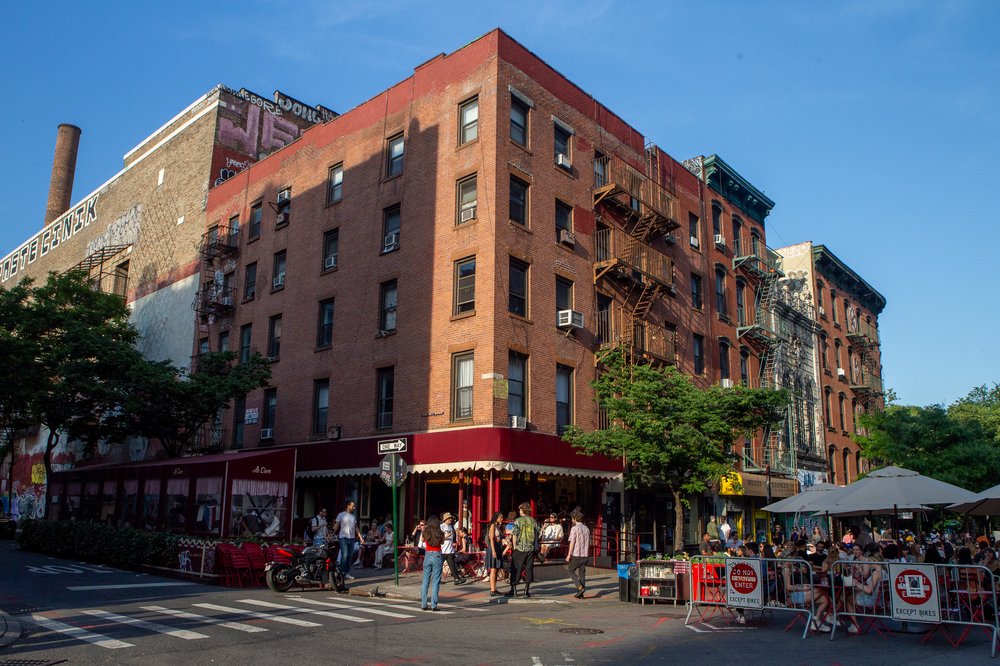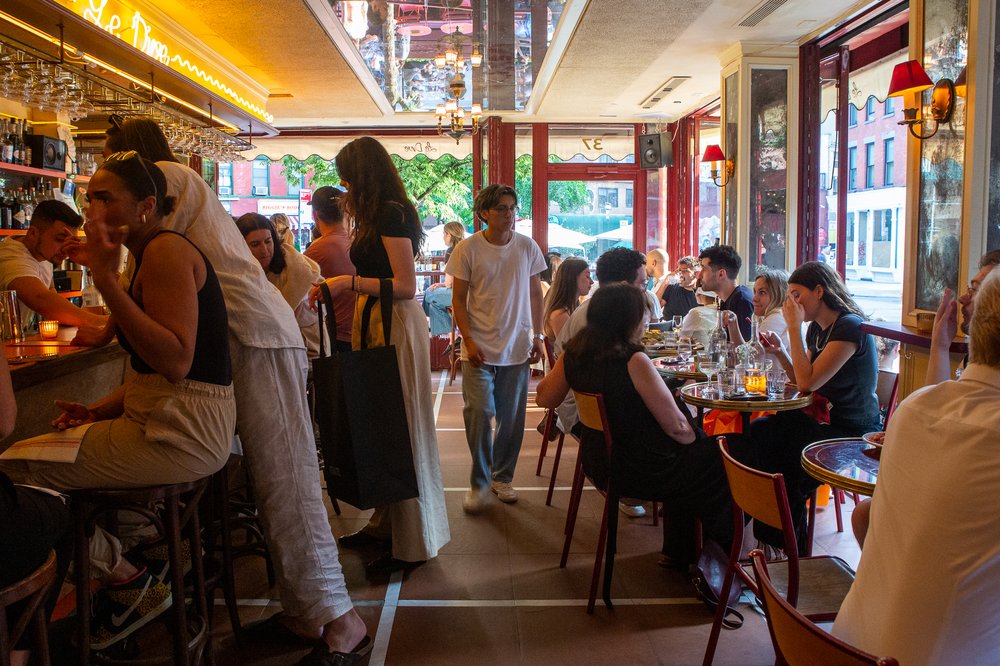This summer is the end of outdoor dining in NYC as we know it
May 27, 2024, 5:30 a.m.
New outdoor dining rules will change the economics of running an NYC restaurant, again

New York City’s streets and sidewalks could look very different starting on Aug. 3.
That’s the deadline for restaurants to either apply for the city’s new outdoor dining program or take down their roadway dining structures, which occupy parking spaces or other parts of the street.
After four years of free, loosely regulated outdoor dining, the new program overseen by the city’s Department of Transportation will add fees, limit sidewalk seating and make roadway sheds hew to extensive rules, which must come down by December but can go back up in April.

“People just built like crazy, you could build on the whole block if the landlords let you,” said Manuel Colon, owner of Manny’s Bistro on the Upper West Side, where he expects to lose half of his 24 outdoor seats. “It was a little bit out of control. The new rules are going to be much more efficient for everyone.”
The regulations come after two years of protracted arguments in the City Council, media, and other public forums over rats, parking spaces, and safety concerns related to outdoor dining.
Restaurant owners are divided
The new rules will change the economics of running an establishment in New York City for the second time this decade, following years of changing dining patterns and record inflation.
“The new outdoor dining program was a compromise,” Andrew Rigie, executive director of the NYC Hospitality Alliance, a trade group for the city’s restaurants and nightlife businesses, wrote in an email. “While not perfect, overall, it’s better for many restaurants across the city than the old system,” he wrote, referring to the pre-pandemic era.
“I’ll be losing my roadside seating, which unfortunately is the most popular seating area,” said Samantha DiStefano, whose restaurant Mama Fox in Bedford-Stuyvesant is the latest of several she’s run in the metro area for nearly 30 years.
“I don't know one small business that can afford to have a seasonal structure on the roadside,” DiStefano said. “Where am I going to get $5,000, $6,000, $7,000 twice a year to pay someone to build it and take it down? And then where am I going to store it, and how much is that going to cost? It's just completely ridiculous to think that we can set these up and break them down.”
A pandemic reset
To hear Jon Neidich tell it, New York’s restaurant industry was already at an inflection point when the pandemic hit.
“Leading up to 2020, rent prices and labor prices were getting to a point where a lot of different kinds of restaurants, their numbers weren’t working anymore,” said Neidich, CEO and founder of Golden Age Hospitality, which operates nightlife hotspots like ACME, The Nines, and Le Dive.
“We were losing the 50-seat dinner-only restaurant, the small bustling place like Prune,” Neidich said, referring to the iconic East Village bistro that closed in March 2020. “The economics were just out of whack.”
The pandemic reset things, Neidich said. For one, rents came down, albeit temporarily. More importantly, outdoor dining allowed restaurants to sometimes double their seating capacity.

Le Dive, Neidich’s constantly packed small plates wine bar on the corner of Canal and Ludlow streets, seats about 60 across two small floors inside. It seats 86 outside – a 143% increase in capacity due entirely to the “anything goes” accommodations the city made to get restaurants through the pandemic.
“A small little 40-seat restaurant that suddenly gets 30 seats outside…you go from a business that’s barely making it to a business that’s super healthy,” Neidich said. “Those additional seats are so essential to the way the economics of a restaurant work.”
Doubling the number of seats can double restaurants' revenue in warmer months without corresponding expenses, Neidich said. Although they have to hire some additional servers to handle the extra customers, costs like rent and utilities, insurance, and kitchen and management labor stay fixed.
“It costs you exactly the same, or similar, to run the smaller restaurant versus the bigger one,” Neidich said.
'If you can afford it, then you can benefit'
Pre-pandemic, only about 1,200 New York City establishments took advantage of outdoor dining, according to the Department of Consumer and Worker Protection, which handled licensing for sidewalk cafes back then.
Two-year permits came with steep fees of $30-$40 per square foot, and landmarking or zoning rules often prohibited sidewalk seating. The dining “sheds” and the Open Streets program, which allows neighborhoods to temporarily close streets to car traffic, didn’t exist at all.
The pandemic opened up sidewalk, roadway and Open Streets dining to everyone for free. Some 12,000 establishments took advantage of the opportunity to expand, according to the Department of Transportation.
Hundreds have applied since the new outdoor dining applications opened in March, according to Transportation Commissioner Ydanis Rodriguez, who expects a wave to come in before the Aug. 3 deadline.
The transportation department expects the new setups will cost restaurants five figures to build, break down, and store in the off-season, with costs varying dramatically by size and design of the new structures. The new fees per square foot of outdoor seating are down significantly from before the pandemic, ranging from $5-$31 per square foot based on location and type.
“It’s going to be about the open market,” Rodriguez said. “Every establishment will make a decision based on what makes sense for them to get a return on their investment.”
DiStefano said there was “absolutely zero” chance she would be applying for the new program, citing the cost. She’s frustrated that the city won’t allow her popular shed to at least stay up through the crucial warm months this year.
“Why not give us till the end of this season?” DiStefano said. “We have a solid two months, all of August and all of September, to be generating revenue.”

She’s unsure whether Mama Fox will survive next year without the additional 30 seats its roadside shed provides. DiStefano sees the new rules benefiting large, well-capitalized restaurant groups, and failing small independent operations like hers.
“If you can afford it, then you can benefit,” DiStefano said.
Nialls Fallon, co-founder of popular restaurants Hart’s, The Fly, and Cervo’s, said his team is waiting for more guidance and a larger selection of vendors who can build the new approved designs, but will be applying later this summer. He feels the new rules are a net positive for the city, after the “wild west” of the past few years.
“We really got thrown a freebie there for a while, but it’s definitely time for clear regulations and rules,” Fallon said. “I agree with a lot of the complaints about rats, and plywood structures falling apart and stinking.”
At The Fly, where a rotisserie chicken and the cheapest bottle of wine will run you well over $100 after tax and tip, Fallon expects outdoor revenue to halve after the changes. Hart’s and Cervo’s will likely be able to maintain their outdoor capacity, he said, though the spacing will have to tighten up.
“When we do the economics for us, it makes complete sense and is absolutely worth it,” Fallon said. “I imagine that a lot of places with lower price points, it might not make as much sense financially for them.”
Neidich, of Golden Age Hospitality, believes the new regulations will hurt many of New York City’s cafes, bars and restaurants.
“A lot of places are gonna lose a lot of their seating, and I think you're going to see another wave of a really difficult time for smaller local businesses,” he said.
CORRECTION: This article has been edited to reflect that roadway sheds must adhere to new rules. However, the sheds’ designs can be determined by the restaurant owner.
Why are Broadway tickets so expensive right now? It’s not just inflation. In Greenpoint, a wacky new birding group is ruffling some feathers